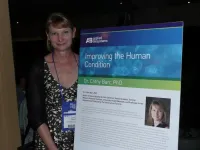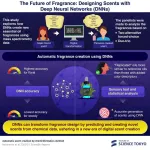(Press-News.org) ITHACA, N.Y. – Cornell University researchers have found the pupil is key to understanding how, and when, the brain forms strong, long-lasting memories.
By studying mice equipped with brain electrodes and tiny eye-tracking cameras, the researchers determined that new memories are being replayed and consolidated when the pupil is contracted during a substage of non-REM sleep. When the pupil is dilated, the process repeats for older memories. The brain’s ability to separate these two substages of sleep with a previously unknown micro-structure is what prevents “catastrophic forgetting” in which the consolidation of one memory wipes out another one.
The findings could lead to better memory enhancement techniques for humans and may help computer scientists train artificial neural networks to be more efficient. The study, under embargo until 11am ET on Jan. 1 in Nature, was led by assistant professors Azahara Oliva and Antonio Fernandez-Ruiz.
Over the course of a month, a group of mice was taught a variety of tasks, such as collecting water or cookie rewards in a maze. Then the mice were outfitted with brain electrodes and tiny spy cameras that hung in front of their eyes to track their pupil dynamics. One day, the mice learned a new task and when they fell asleep, the electrodes captured their neural activity and the cameras recorded the changes to their pupils.
“Non-REM sleep is when the actual memory consolidation happens, and these moments are very, very short periods of time undetectable by humans, like 100 milliseconds,” Oliva said. “How does the brain distribute these screenings of memory that are very fast and very short throughout the overall night? And how does that separate the new knowledge coming in, in a way that it doesn’t interfere with old knowledge that we already have in our minds?”
The recordings showed that the temporal structure of sleeping mice is more varied, and more akin to the sleep stages in humans, than previously thought. By interrupting the mice’s sleep at different moments and later testing how well they recalled their learned tasks, the researchers were able to parse the processes. When a mouse enters a substage of non-REM sleep, its pupil shrinks, and it’s here the recently learned tasks – i.e., the new memories – are being reactivated and consolidated while previous knowledge is not. Conversely, older memories are replayed and integrated when the pupil is dilated.
“It’s like new learning, old knowledge, new learning, old knowledge, and that is fluctuating slowly throughout the sleep,” Oliva said. “We are proposing that the brain has this intermediate timescale that separates the new learning from the old knowledge.”
The research was supported by the National Institutes of Health, the Sloan Foundation, the Whitehall Foundation, the Klingenstein-Simons Fellowship Program, and the Klarman Fellowships Program.
END
Pupil size in sleep reveals how memories are sorted, preserved
2025-01-01
ELSE PRESS RELEASES FROM THIS DATE:
Revealing a key mechanism of rapid centromere evolution
2025-01-01
A joint research group team led by Sayuri Tsukahara and Tetsuji Kakutani of the University of Tokyo has clarified a mechanism of how retrotransposons, genetic elements that can “jump around” chromosomes and are known drivers of evolution, preferentially insert in the centromere. The findings were published in the journal Nature.
The centromere is the thinnest part of the chromosome that divides it into a long and short arm, much like how the waist separates the upper and lower body. Its role in transmitting information via cell division has been preserved ...
A tour de force: Columbia engineers discover new “all-optical” nanoscale sensors of force
2025-01-01
New York, NY—January 1, 2025—Mechanical force is an essential feature for many physical and biological processes. Remote measurement of mechanical signals with high sensitivity and spatial resolution is needed for a wide range of applications, from robotics to cellular biophysics and medicine and even to space travel. Nanoscale luminescent force sensors excel at measuring piconewton forces, while larger sensors have proven powerful in probing micronewton forces. However, large gaps remain in the force magnitudes that can be probed remotely from subsurface ...
Ancient DNA unlocks new understanding of migrations in the first millennium AD
2025-01-01
Francis Crick Institute press release
Under strict embargo: 16:00 GMT Wednesday 1 January 2025
Peer reviewed
Observational study
Ancient people
Ancient DNA unlocks new understanding of migrations in the first millennium AD
Waves of human migration across Europe during the first millennium AD have been revealed using a more precise method of analysing ancestry with ancient DNA, in research led by the Francis Crick Institute.
Researchers can bring together a picture of how people moved across the world by looking at changes in their DNA, but this becomes a lot harder when historical ...
MIT scientists pin down the origins of a fast radio burst
2025-01-01
Fast radio bursts are brief and brilliant explosions of radio waves emitted by extremely compact objects such as neutron stars and possibly black holes. These fleeting fireworks last for just a thousandth of a second and can carry an enormous amount of energy — enough to briefly outshine entire galaxies.
Since the first fast radio burst (FRB) was discovered in 2007, astronomers have detected thousands of FRBs, whose locations range from within our own galaxy to as far as 8 billion light-years away. Exactly how ...
Researchers reveal why the lung is a frequent site of cancer metastasis
2025-01-01
Leuven, 2 January 2024 – Researchers from the lab of Prof. Sarah-Maria Fendt (VIB-KU Leuven) and colleagues have uncovered that the availability of the amino acid aspartate is one reason why the lung is a frequent organ of metastasis. Their work appears in Nature and improves our understanding of cancer biology while providing the foundation for new therapeutic interventions in metastatic diseases.
A role for aspartate
More than half of cancer patients in whom the cancer spreads beyond the primary site have lung metastases. What makes the lungs such a ...
Aging may change some brain cells more than others
2025-01-01
EMBARGOED FOR RELEASE: Jan. 1, 2025, 11 a.m. ET
CONTACT:
NIAPressTeam@mail.nih.gov, 301-496-1752
Aging may change some brain cells more than others
NIH-funded mouse study provides roadmap for how aging may alter brain cell genetic activity
Based on new brain mapping research funded by the National Institutes of Health (NIH), scientists have discovered that not all cell types in the brain age in the same way. They found that some cells, such as a small group of hormone-controlling cells, may undergo more age-related changes in genetic activity than others. The results, published ...
Special issue of APA’s official journal focuses on psychedelic medication
2025-01-01
WASHINGTON, D.C., Jan. 1, 2025—As the body of research grows around the potential promise of psychedelic medications in psychiatry, many questions and challenges remain. The January issue of the American Journal of Psychiatry features a series of articles, including new research, reviews and commentaries, on the use of these treatments.
The issue addresses many of the ongoing challenges and looming questions in the field of psychiatric psychedelic research and treatment. These include issues relevant to basic ...
Geneticist unlocks mysteries of childhood psychiatric disorders through innovative research
2024-12-31
TORONTO, Ontario, Canada, 31 December 2024 - In a comprehensive Genomic Press Interview, leading geneticist Dr. Cathy Barr unveils crucial discoveries about the complex interplay between genes and childhood psychiatric disorders. As a Senior Scientist at both the Hospital for Sick Children and Krembil Research Institute, Dr. Barr's research illuminates the genetic foundations of conditions including depression, attention-deficit/hyperactivity disorder, reading disabilities, and Tourette syndrome.
"After decades of searching ...
New study uncovers key insights into protein interactions in Duchenne muscular dystrophy, paving way for more targeted therapies
2024-12-31
AURORA, Colo. (Dec. 31, 2024) – A groundbreaking study has shed light on the complex interactions between dystrophin, a protein critical to muscle stability, and its partner protein, dystrobrevin, offering new pathways for understanding and treating Duchenne Muscular Dystrophy (DMD).
Published in the December issue of the Journal of Biological Chemistry, researchers characterize the mysterious C-terminal (CT) domain of dystrophin and its role in stabilizing cellular membranes across various tissues.
DMD, a severe genetic disorder that causes muscle weakness and shortens lifespans, arises from mutations in the gene encoding ...
Revolutionizing fragrance design using deep neural networks (DNNs) scent profiles from chemical data
2024-12-31
Scientific research explores the potential of DNNs in transforming fragrance design. By analyzing the sensing data of 180 essential oils, the DNN was trained using the odor descriptor data from 94 essential oils to generate fragrance profiles, validated through sensory evaluations to align with human olfactory perceptions. The study underscores the technological ability to streamline fragrance creation, reduce costs, and foster innovation, opening up exciting possibilities for personalized and scalable scent development.
Deep Neural Networks (DNNs) have become an essential driver of innovation across various industries, ...





